Demolition of Tianjin’s old city
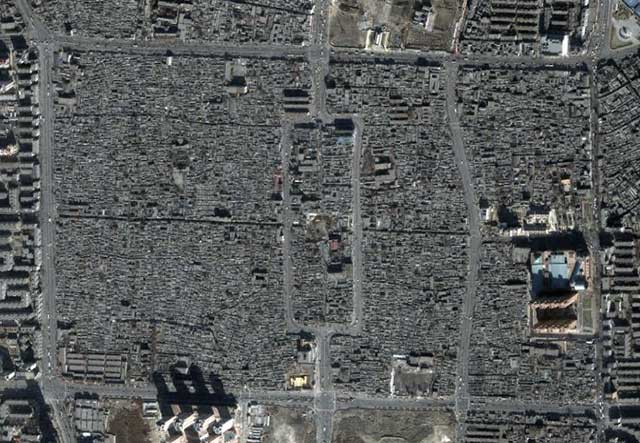
Google Earth imagery of the old city of Tianjin in November 2000 and January 2004 (move over image with your mouse to reveal After image)
Mass demolition of old districts is something of a “normal” thing in China, but to people who imagine that the large-scale destruction of historic city centres is a thing of the relatively distant past, the fate of Tianjin’s old chinese city serves as a sobering case. As Google Earth imagery shows, between November 2000 and January 2004 almost the entirety of the area within the old city walls (defined by the large roads forming a horizontal rectangle that replaced the walls), and a considerable part of historic districts outside the walls, was destroyed. Apart from a couple of important temples, hardly a building escaped the destruction. Between 2004 and 2009 the entire area was rebuilt primarily with high-rise residential buildings and a grid of large wide avenues (see 2009 airphoto below).
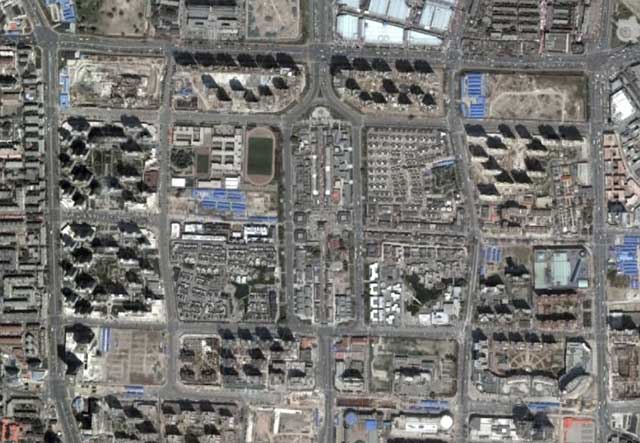
Google Earth imagery of the old city of Tianjin in May 2009
Two streets were rebuilt (not preserved) as “historic” streets in faux Qing style architecture – in the airphoto you can clearly see that the size and roofs of these buildings are not those of the original old buildings, and this type of street is certainly not unique to Tianjin, nor is the concept of demolishing a historic district and replacing it with a sanitized disneyfied historical recreation. Below in the central detail area you can also see the incredibly fine grain of the original historic city fabric.
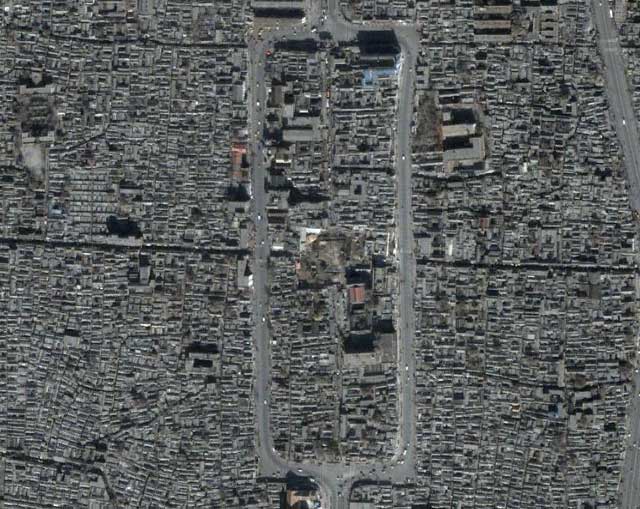
Google Earth imagery of the old city of Tianjin in November 2000 and January 2004 (move over image with your mouse to reveal After image)
East of the old city walls was an old commercial district along the Hai River, now home to something called “Ancient Culture Street”, but again you can clearly see from the 2000 airphoto (see rollover below) just how much of the historic fabric has been preserved (one temple and 6 courtyard warehouses along a lane). Even Beijing has been guilty of this attitude towards a “historic” street in the Qianmen St “renovation” which includes an “old tyme” streetcar route and restaurant staff dressed up in Qing dynasty costumes.
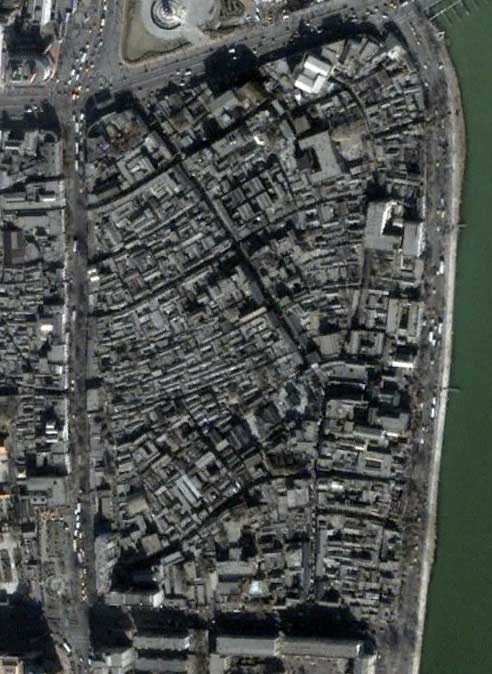
Google Earth imagery of the old city of Tianjin in November 2000 and May 2009 (move over image with your mouse to reveal After image)
It seems pretty odd (but fairly typical in China) to have a city concerned to display and exploit its historic pedigree, while at the same time indiscriminately demolishing its own genuine heritage. The reasons are certainly complex and numerous, but foremost among them seems to be a perception that the actual heritage is not nearly impressive or valuable enough to warrant saving, nor, if saved, would give the city’s history the requisite prestige, dignity and respect. Most chinese cities seem to have decided that as far as both tourists and city residents are concerned, it’s far more popular, profitable, and prestigious to create sanitized reproduction tourist traps.
Of course, the excuse of “face” may just be masking a deeper reason for demolition and development: money. Many current residents of the overcrowded, underserviced and dilapidated buildings in older districts tend to be eager to receive the government rehousing compensation that comes from the repossession of their homes, giving them the opportunity to move into more humanely spacious and serviced modern apartments. Meanwhile, the government is just as eager to earn the profits from selling (or should we say flipping?) the repossessed and cleared land to the highest bidding developer. Needless to say, the profits available from renovating buildings within the existing fabric would fall far short of those from even relatively low-density redevelopment, and given that there are no property taxes in China, cities are basically forced to make money from land sales. Meanwhile, the compensation for the original residents tends to allow them to buy cheap apartments far out at the edges of the city, while the property prices in the older districts inflate endlessly beyond the reach of even many of the middle class.
Further complicating the situation in Tianjin is the city’s history (or in this case, lack of ancient history). As history in China goes, Tianjin’s 600 years of establishment (at least as a walled, officially recognized city) pales in comparison to most chinese cities. Then, like Shanghai, Tianjin was opened up to foreign concessions in the 19th century and the history of the chinese city essentially was overshadowed from that point forward. As a result, the many western buildings of the former foreign concessions have been seen as far more valuable than the messy, dilapidated, overcrowded chinese city.
Regardless of the reasons, the end result is the same: widespread demolition of whole districts, destroying hundreds of years of history. The scale of the destruction can be so huge, it makes you wonder if the city has been bombed during a war or experienced some horrendous natural catastrophe. Alas, no, this is a wholly manmade and peacetime catastrophe of epic proportions.
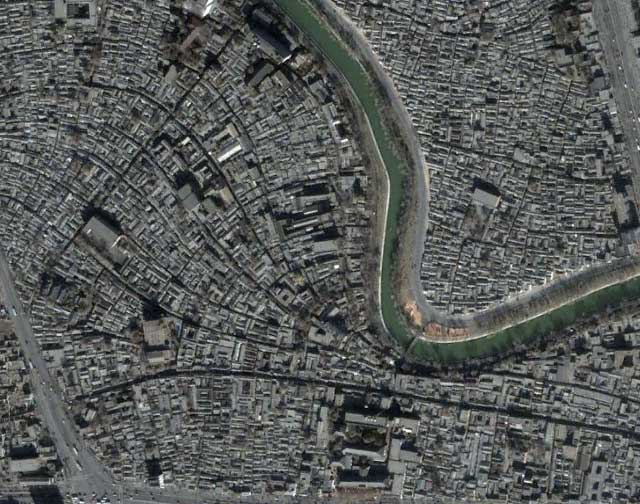
Google Earth imagery of area north of the walled old city of Tianjin in November 2000 and May 2009 (move over image with your mouse to reveal After image)

19 Comments so far
Leave a comment
[…] More currently, I stumbled on a blog today with a series of incredible rollover images using Google Earth to capture the large scale of this demolition. This was the first I had seen this technique and it was as powerful as it was unsettling. (I’m not tech savvy enough to recreate this here, so just click the images below to be whisked away to the *inspiring* Bricoleurbanism blog) […]
By Gentrification = Demolition? « LIVING architecture on 06.18.10 7:34 pm
This is unbelievable. To imagine the destruction of an ancient place like this on a wholesale level is horrendous. Heritage must be treasured, it is about a sense of place, and what your ancestors achieved and how they lived. A disgraceful act
By dave edwards on 10.08.10 11:16 am
Very good article, thank you very much !
By Félix on 10.22.10 2:57 am
[…] the overall effect so far from the air perhaps doesn’t seem as shocking as the demolition of Tianjin’s old town I wrote about earlier (without more uptodate airphotos, the destruction is not yet obvious, the […]
By Bricoleurbanism » Progress of Demolition of Kashgar on 10.29.10 12:19 am
[…] do not know why I have not come across it sooner. It’s got some fabulous posts, for example on the razing of old Tianjin, or the disappearance of Shanghai’s Wujiang Lu food street (whose last days I also saw), or […]
By Ogle Earth on 11.12.10 6:29 am
This is like what was done in many parts of Sweden in the 60s and 70s, whole cityblocks were demolished for, basically no other reason than in with the new, out with the old. In effect, we’ve lost many historic neighbourhoods and individual buildings in the name of modernization, something that many people deeply regret today.
Shame that history should repeat itself, especially in a country such as China, where the effects have the potential to be so much more devastating.
By Ola on 11.15.10 10:41 am
[…] do not know why I have not come across it sooner. It’s got some fabulous posts, for example on the razing of old Tianjin, or the disappearance of Shanghai’s Wujiang Lu food street (whose last days I also saw), or […]
By Check out Bricoleurbanism | Digital Mobile Map on 12.10.10 9:50 am
its like a dead city without any greenery, I think it should be developed while keeping its characteristics of old china
By sachie on 01.04.11 12:42 am
I visited ancient culture street for several years on my visits to Tianjin, and was stunned to arrive the one autumn and find half of it had been bulldozed. The rest soon followed, and the ancient mixture of shops and businesses was eventually replaced by a bad copy done all in a single style.
My (Chinese) spouse explained that a new mayor of Tianjin (who despised the old mayor) had been assigned by Beijing. Ancient culture street had been a favorite district of the old mayor, and he had protected it. In an act of spite, the new mayor had it demolished. Later, when it was discovered that it had been named a heritage site, he had it rebuilt with his “own money”, but the whispers and knowing nods around the city indicated that he made a handsome profit from the destruction and subsequent restoration.
It is a fun place to visit, but a pale shadow of what it once was.
By Adrian on 01.09.11 4:34 am
I lived in Tianjin from 1996-2000. I wandered those now vanished neighborhoods and really appreciated how complete they were. Few people know how beautiful Tianjin was architectually, the old city and the concessions areas were second only to Shanghai. I didn’t take so many piictures because it felt like that stuff would be there forever. Then around the time I left the destruction started, slowly, but when you see the oldest best buildings being knocked down, you just know the old hutongs don’t stand a chance. Luckily large parts of the British and French concessions have been saved, but they are mostly banks, a hotel or two and some villas. These photos really ruined my day!
By Mikecheck on 02.11.11 9:55 pm
amazing post, great blog, incredibly depressing content
By Magnus on 02.15.11 7:08 pm
[…] do not know why I have not come across it sooner. It’s got some fabulous posts, for example on the razing of old Tianjin, or the disappearance of Shanghai’s Wujiang Lu food street (whose last days I also saw), or […]
By Open Mobile Map » Check out Bricoleurbanism on 03.17.11 6:15 am
thanks for your wonderful post. the more powerful it is, the more heartbreaking. I am from Tianjin.
By Qi on 10.24.11 12:13 pm
Looking at those photos bring me back to the 1980s when I was riding my bicycle to visit my grandma. It took me 30 minutes or so to cross the old city via its main road. I can still remember the old hutong, small shops, and it’s people. One interesting thing I want to share with you is the so called “main road” is not wide enough for cars! But it is a way of life for its people, close my eyes, I can still remeber the sound of Peking opera and the smell of Jasmine teas. I have to say the past 30 years probably saw the biggest change in China history, everytime I came back to visit my hometown I saw people moving into new aprtments, more cars on the road, and they getting better education and health care. But all these really coming with huge price tags, the image tells everything. Luckily for me, my childhood memories will stay with me forever.
By YD on 01.31.12 10:15 pm
incredible investigation into a heartbreaking and regretable situation. This kind of erasure and rebuilding of historic districts does generate vast short term wealth but sadly, the long term costs are uncalculably greater. Along with loss of buildings, goes identity, wellbeing, continuity, understanding of the past and the future. It’s so sad to see the destruction of all these urban treasures for short term financial gain. China will bitterly regret this period very soon and mourn the self inflicted loss for generations to come. Lets hope someone in China can put forw3ard the case for acknowledgign the huge long-term financial and cultural value of historic districts before they are all lost forever.
By peter kelly on 11.05.12 9:27 am
The only difference between these changes happening recently in China, and more distant changes in many other developed countries is that it happened more quickly and more recently. So, generalized complaints about detsroying history is justified, but singling out Chin for special criticism is not.
By Qu Dawei on 11.05.12 8:50 pm
You couldn’t be more wrong – how about suggesting a single example in a developed country that is remotely on the scale of the destruction happening in China in the last 20 years? Most cities where redevelopment happened at a scale that even comes close were the result of extensive destruction because of war – in other words, the areas were already wiped out completely. Even the famous example of Haussmann’s dramatic renovation of Paris by cutting wide boulevards through the existing city left the medieval fabric of the city intact in the streets off the new boulevards – a fabric of street network, building form and character that survives to this day, even when almost none of the original medieval buildings have survived. Which major European city does not have a relatively intact historic core showcasing the unique character, history and fabric of the city? Which major North American city does not still use the street fabric and parcel fabric inherited from its original planning? Add to this the fact that we are now well aware of the value, preciousness and irreplaceability of our cities’ historic fabrics, and the destruction in China becomes even less understandable and more unforgivable. There are many historic architects and preservationists in China trying their best to preserve what they can, but they are not in positions influential enough to prevent large scale destruction. China seems to spend a lot of time reminding everyone how long and glorious its history is, while at the same time they are busy erasing as much physical evidence of that history as possible, all for short-term, short-sighted profits, padding a few politicians’ resumes and holding off the introduction of property tax for perhaps a decade.
By rc on 11.05.12 9:28 pm
I’m stunned! I studied in Tianjin in 1994-5, returning later in 2008 to a visit (overnight transit to airport). Everything that made Tianjin interesting has gone. The Chinese never cease to evoke the destruction of the Summer Palace by Allied Forces for political reasons but it is they themselves who have obliterated their cultural heritage. As a former student of urbanism at LSE, I am stunned
By Nick Prendergast on 11.28.14 5:42 am
Very good Google maps here.I have witnessed this destruction and now the massive overcrowding into the 5 Streets of the ‘selfie crowds.I have been here since 2001 and the city and lot of Chinese cities for that matter are now no more than car parks.It is also very hard to find authentic historical material to research a lot of the original residences.
By Barry on 10.14.18 11:36 pm
Leave a comment
Line and paragraph breaks automatic, e-mail address never displayed, HTML allowed:
<a href="" title=""> <abbr title=""> <acronym title=""> <b> <blockquote cite=""> <cite> <code> <del datetime=""> <em> <i> <q cite=""> <s> <strike> <strong>